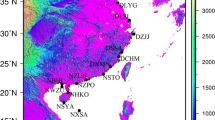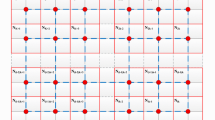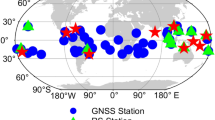Abstract
Precipitable water vapor (PWV) is an essential parameter in numerical weather prediction and climate research. Existing global empirical PWV models rely on a single coefficient for vertical adjustment and lack geographical differentiation. Therefore, this study developed the global PWV vertical adjustment model (GPWV-H) by considering the time-varying lapse rate using the fifth-generation European Centre for Medium-Range Weather Forecasts Atmospheric Reanalysis (ERA5) from 2012 to 2017. The performance of the GPWV-H model in vertical adjustment is evaluated using multi-source PWV data and compared with the conventional empirical model (EPWV-H). The numerical results are as follows: (1) The bias and root mean square (RMS) of the GPWV-H model are − 0.10/ − 0.35 mm and 1.43/1.07 mm, respectively, when ERA5 and radiosonde PWV profiles were used as reference which are 9.3 and 5.9% (in RMS) lower than EPWV-H model; (2) The GPWV-H model improved by 15.1–17.1 and 0.8–1.6% compared to the non-adjustment and the EPWV-H model, respectively, when interpolating Second Modern-Era Retrospective Analysis for Research and Applications (MERRA-2) with various grid resolutions to radiosonde stations. These results indicate that the GPWV-H model outperforms the EPWV-H model regarding global PWV interpolation accuracy and stability and has a promising application tendency in global real-time and high-precision water vapor monitoring.

















Similar content being viewed by others
Data Availability
The MERRA-2 data can be accessed at https://goldsmr4.gesdisc.eosdis.nasa.gov/data/MERRA2/. The radiosonde data are obtained from http://www1.ncdc.noaa.gov/pub/data/igra/. The ERA5 data are available at https://cds.climate.copernicus.eu/cdsapp#!/search?type=dataset.
References
Askne J, Nordius H (2016) Estimation of tropospheric delay for microwaves from surface weather data. Radio Sci 22(3):379–386. https://doi.org/10.1029/RS022i003p00379
Bevis M, Businger S, Herring TA, Rocken C, Anthes RA, Ware RH (1992) GPS meteorology: remote sensing of atmospheric water vapor using the global positioning system. J Geophys Res 97:15787–15801. https://doi.org/10.1029/92JD01517
Bosilovich MG, Robertson FR, Takacs L, Molod A, Mocko D (2017) Atmospheric water balance and variability in the MERRA-2 reanalysis. J Climate 30(4):1177–1196. https://doi.org/10.1175/jcli-d-16-0338.1
Chen B, Tan J, Wang W, Dai W, Ao M, Chen C (2023) Tomographic reconstruction of water vapor density fields from the integration of GNSS observations and Fengyun-4A products. IEEE Trans Geosci Remote Sens 61:1–12. https://doi.org/10.1109/TGRS.2023.3239392
Dousa J, Elias M (2014) An improved model for calculating tropospheric wet delay. Geophys Res Lett 41(12):4389–4397. https://doi.org/10.1002/2014GL060271
Emardson TR, Johansson JM (1998) Spatial interpolation of the atmospheric water vapor content between sites in a ground-based GPS Network. Geophys Res Lett 25(17):3347–3350. https://doi.org/10.1029/98GL02504
Gupta P, Verma S, Bhatla R, Chandel AS, Singh J, Payra S (2020) Validation of surface temperature derived From MERRA-2 reanalysis against IMD gridded data set over India. Earth Space Sci 7(1):e2019EA000910. https://doi.org/10.1029/2019EA000910.
Huang L, Jiang W, Liu L, Chen H, Ye S (2019) A new global grid model for the determination of atmospheric weighted mean temperature in GPS precipitable water vapor. J Geodesy 93(2):159–176. https://doi.org/10.1007/s00190-018-1148-9
Huang L, Mo Z, Liu L, Xie S (2021a). An empirical model for the vertical correction of precipitable water vapor considering the time-varying lapse rate for Mainland China (in Chinese). Acta Geod et Cartogr 50(10) 1320–1330. https://doi.org/10.11947/j.AGCS.2021.20200530.
Huang L, Mo Z, Liu L, Zeng Z, Chen J, Xiong S, He H (2021b) Evaluation of Hourly PWV products derived From ERA5 and MERRA-2 over the Tibetan plateau using ground-based GNSS observations by two enhanced models. Earth Space Sci 8(5): e2020EA001516. https://doi.org/10.1029/2020EA001516.
Huang L, Wang X, Xiong S, Li J, Liu L, Mo Z, Fu B, He H (2022) High-precision GNSS PWV retrieval using dense GNSS sites and in-situ meteorological observations for the evaluation of MERRA-2 and ERA5 reanalysis products over China. Atmos Res 276. https://doi.org/10.1016/j.atmosres.2022.106247.
Huang L, Zhu G, Liu L, Chen H, Jiang W (2021c) A global grid model for the correction of the vertical zenith total delay based on a sliding window algorithm. GPS Solut 25(3):98. https://doi.org/10.1007/s10291-021-01138-7
Jin S, Luo OF (2009) Variability and climatology of PWV from global 13-year GPS observations. IEEE Trans Geosci Remote Sens 47(7):1918–1924. https://doi.org/10.1109/TGRS.2008.2010401
Kouba J (2008) Implementation and testing of the gridded Vienna Mapping Function 1 (VMF1). J Geodesy 82:193–205. https://doi.org/10.1007/s00190-007-0170-0
Lavers DA, Simmons A, Vamborg F, Rodwell MJ (2022) An evaluation of ERA5 precipitation for climate monitoring. Q J Roy Meteor Soc 148(748):3152–3165. https://doi.org/10.1002/qj.4351
Leckner B (1978) The spectral distribution of solar radiation at the earth’s surface—elements of a model. Sol Energy 20:143–150. https://doi.org/10.1016/0038-092X(78)90187-1
Li X, Tan H, Li X, Dick G, Wickert J, Schuh H (2018) Real-time sensing of precipitable water vapor from BeiDou observations: Hong Kong and CMONOC networks. J Geophys Res-Atmos 123(15):7897–7909. https://doi.org/10.1029/2018JD028320
Liu S, Zhang K, Wu S, Zhang M, Zhu D, Zhang W, Hu A, Shi Z, Shi J, Li L, Hao Y (2023) An improved GNSS tropospheric tomographic model with an extended region and combining virtual signals. Atmos Res 287:106703. https://doi.org/10.1016/j.atmosres.2023.106703.
Lu C, Li X, Ge M, Heinkelmann R, Nilsson T, Soja B, Dick G, Schuh H (2016) Estimation and evaluation of real-time precipitable water vapor from GLONASS and GPS. GPS Solut 20(4):703–713. https://doi.org/10.1007/s10291-015-0479-8
Mo Z, Zeng Z, Huang L, Liu L, Huang L, Zhou L, Ren C, He H (2021) Investigation of Antarctic precipitable water vapor variability and trend from 18 Year (2001 to 2018) data of four reanalyses based on radiosonde and GNSS observations. Remote Sens 13(19):3901. https://doi.org/10.3390/rs13193901
Molod A, Takacs L, Suarez M, Bacmeister J (2015) Development of the GEOS-5 atmospheric general circulation model: evolution from MERRA to MERRA2. Geosci Model Development 8(5):1339–1356. https://doi.org/10.5194/gmd-8-1339-2015
Onn F, Zebker HA (2006) Correction for interferometric synthetic aperture radar atmospheric phase artifacts using time series of zenith wet delay observations from a GPS network. J Geophys Res 111(B9):B09102. https://doi.org/10.1029/2005JB004012
Parracho AC, Bock O, Bastin S (2018) Global IWV trends and variability in atmospheric reanalyses and GPS observations. Atmos Chem Phys 18(22):16213–16237. https://doi.org/10.5194/acp-18-16213-2018
Reitan CH (1963) Surface dew point and water vapor aloft. J Appl Meteor 2:776–779. https://doi.org/10.1175/1520-0450(1963)002%3c0776:SDPAWV%3e2.0.CO;2
Ross RJ, Elliott WP (2001) Radiosonde-based northern hemisphere tropospheric water vapor trends. J Climate 14(7):1602–1612. https://doi.org/10.1175/1520-0442(2001)014%3c1602:Rbnhtw%3e2.0.Co;2
Rowe PM, Miloshevich LM, Turner DD, Walden VP (2008) Dry bias in Vaisala RS90 radiosonde humidity profiles over Antarctica. J Atmos Ocean Tech 25(9):1529–1541. https://doi.org/10.1175/2008jtecha1009.1
Sam Khaniani A, Nikraftar Z, Zakeri S (2020) Evaluation of MODIS Near-IR water vapor product over Iran using ground-based GPS measurements. Atmos Res 231: 104657. https://doi.org/10.1016/j.atmosres.2019.104657.
Srivastava A (2021) Accuracy assessment of reanalysis datasets for GPS-PWV estimation using Indian IGS stations observations. Geocarto Int, pp 1–19. https://doi.org/10.1080/10106049.2021.2022015.
Ssenyunzi RC, Oruru B, D’ujanga FM, Realini E, Barindelli S, Tagliaferro G, von Engeln A, van de Giesen N (2020) Performance of ERA5 data in retrieving Precipitable Water Vapour over East African tropical region. Adv Space Res 65(8):1877–1893. https://doi.org/10.1016/j.asr.2020.02.003
Tomasi C (1977) Precipitable water vapor in atmospheres characterized by temperature inversions. J Appl Meteorol Clim 16(3):237–243. https://doi.org/10.1175/1520-0450(1977)016%3c0237:Pwviac%3e2.0.Co;2
Tomasi C (1981) Determination of the total precipitable water by varying the intercept in Reitan’s relationship. J Appl Meteorol Clim 20(9):1058–1069. https://doi.org/10.1175/1520-0450(1981)020%3c1058:Dottpw%3e2.0.Co;2
Vázquez B, Grejner-Brzezinska DA (2013) GPS-PWV estimation and validation with radiosonde data and numerical weather prediction model in Antarctica. GPS Solut 17(1):29–39. https://doi.org/10.1007/s10291-012-0258-8
Wan M, Zhang K, Wu S, Sun P, Li L (2022) Development of a new vertical water vapor model for GNSS water vapor tomography. Remote Sens 14(22):5656. https://doi.org/10.3390/rs14225656
Wang X, Chen F, Ke F, Xu C (2022) An empirical grid model for precipitable water vapor. Remote Sens 14(23):6174. https://doi.org/10.3390/rs14236174
Yang F, Sun Y, Meng X, Guo J, Gong X (2023) Assessment of tomographic window and sampling rate effects on GNSS water vapor tomography. Satell Navig 4(1):7. https://doi.org/10.1186/s43020-023-00096-4
Yao Y, Zhao Q (2016) Maximally using GPS observation for water vapor tomography. IEEE Trans Geosci Remote Sens 54(12):7185–7196. https://doi.org/10.1109/TGRS.2016.2597241
Zhai P, Eskridge RE (1997) Atmospheric water vapor over China. J Climate 10(10):2643–2652. https://doi.org/10.1175/1520-0442(1997)010%3c2643:Awvoc%3e2.0.Co;2
Zhang B, Yao Y, Xu C (2015) Global empirical model for estimating water vapor scale height (in Chinese). Acta Geod et Cartogr 44(10):1085–1091. https://doi.org/10.11947/j.AGCS.2015.20140664.
Zhang H, Yuan Y, Li W, Zhang B (2019) A real-time precipitable water vapor monitoring system using the National GNSS Network of China: method and preliminary results. IEEE J Sel Top Appl Earth Obs Remote Sens 12:1587–1598. https://doi.org/10.1109/JSTARS.2019.2906950
Zhao Q, Du Z, Li Z, Yao W, Yao Y (2022) Two-step precipitable water vapor fusion method. IEEE Trans Geosci Remote Sens 60:1–10. https://doi.org/10.1109/TGRS.2021.3120742
Acknowledgements
This study is supported by the National Natural Science Foundation of China (Nos. 42274043), State Key Laboratory of Geodesy and Earth's Dynamics, Innovation Academy for Precision Measurement Science and Technology, Chinese Academy of Sciences (SKLGED2023-3-1), Guangxi Natural Science Foundation of China (2023GXNSFAA026434), Innovation Project of Guangxi Graduate Education (YCSW2023338) and the “Ba Gui Scholars” program of the provincial government of Guangxi. The authors thank ECMWF for providing the ERA5 reanalysis data, NASA for providing the MERRA-2 reanalysis data and IGRA for providing access to the radiosonde data.
Author information
Authors and Affiliations
Contributions
LH, WL, ZM and HZ conceptualization, methodology and formal analysis; LH and WL and ZM, software; LH, WL and ZM, validation; FC, and LL, investigation; LL, WJ, resources; LH, JL, FC, data curation; LH, ZM and WL writing—original draft preparation; LH and HZ, writing—review and editing; LH, FC, and LL, funding acquisition. All authors have read and agreed to the published version of the manuscript.
Corresponding authors
Ethics declarations
Conflict of interest
The authors declare no competing interests.
Additional information
Publisher's Note
Springer Nature remains neutral with regard to jurisdictional claims in published maps and institutional affiliations.
Rights and permissions
Springer Nature or its licensor (e.g. a society or other partner) holds exclusive rights to this article under a publishing agreement with the author(s) or other rightsholder(s); author self-archiving of the accepted manuscript version of this article is solely governed by the terms of such publishing agreement and applicable law.
About this article
Cite this article
Huang, L., Liu, W., Mo, Z. et al. A new model for vertical adjustment of precipitable water vapor with consideration of the time-varying lapse rate. GPS Solut 27, 170 (2023). https://doi.org/10.1007/s10291-023-01506-5
Received:
Accepted:
Published:
DOI: https://doi.org/10.1007/s10291-023-01506-5




